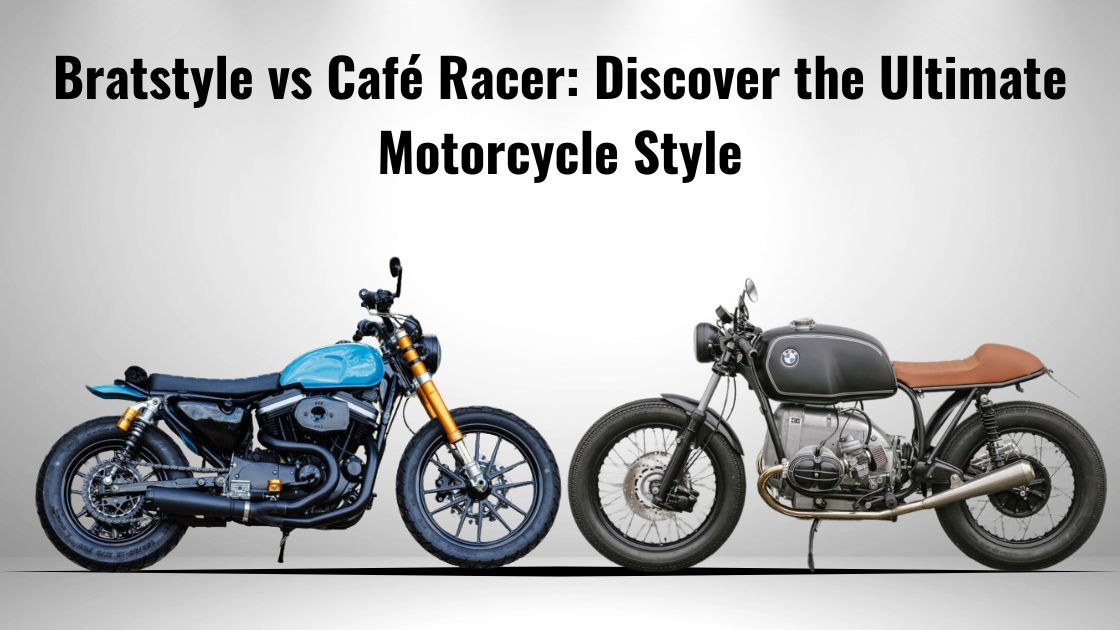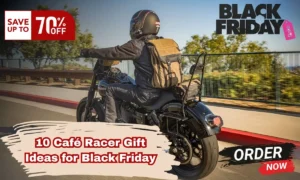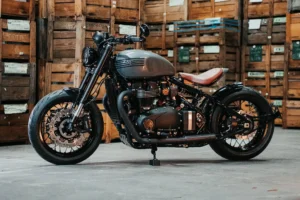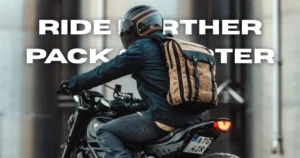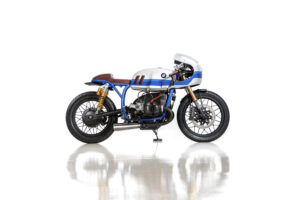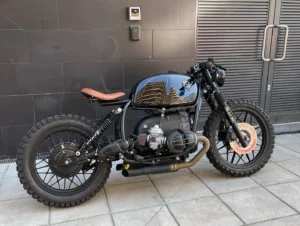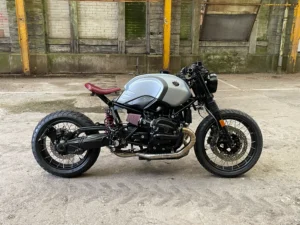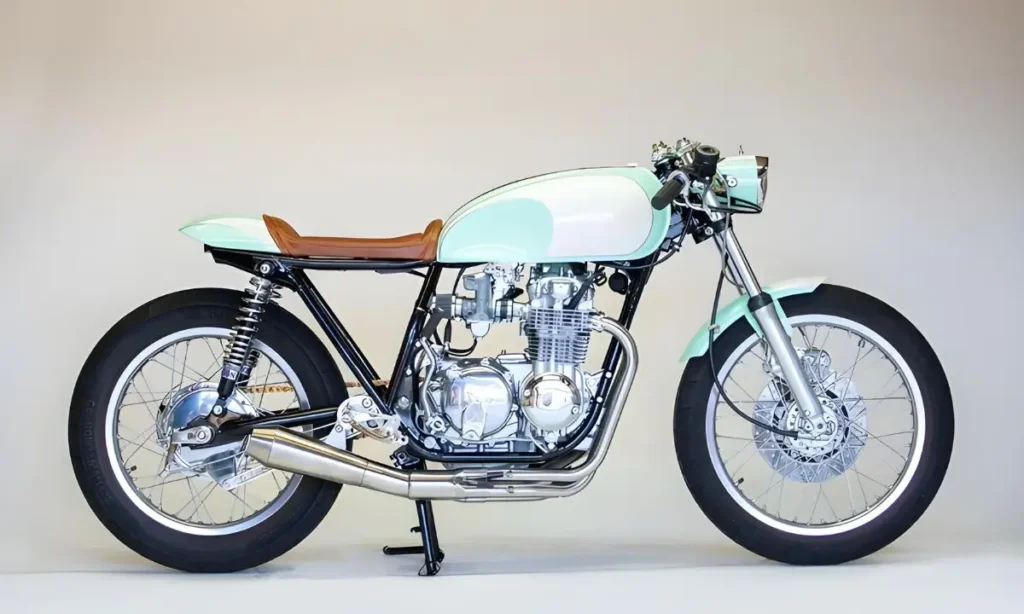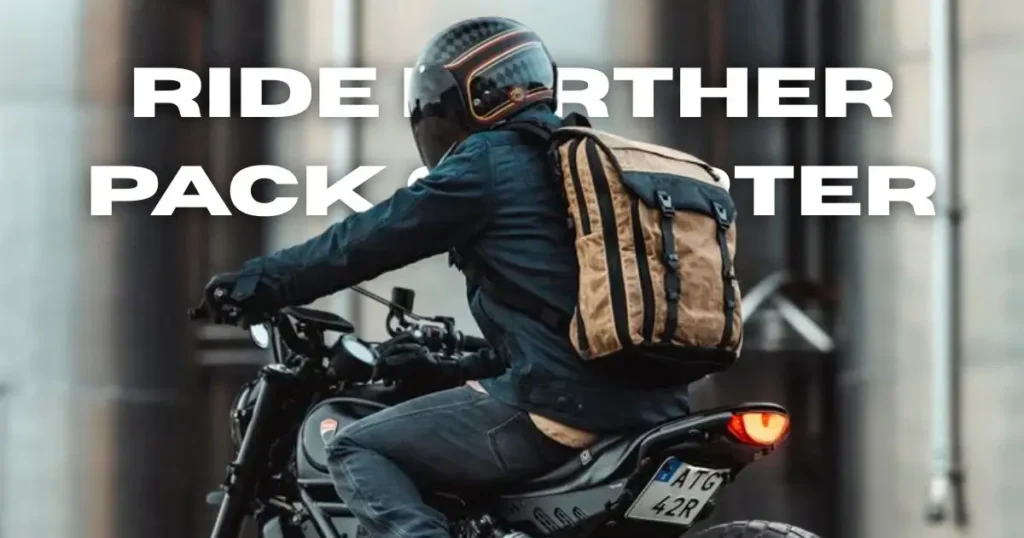Table of Contents
ToggleBratstyle and Café Racer are two of the most iconic styles in custom motorcycle culture. Both represent strong design traditions, with roots in different parts of the world. Bratstyle began in Japan with a focus on simplicity, low stance, and everyday function. Café Racers trace back to the UK, where riders built fast, stripped-down bikes inspired by racing.
These two styles may seem similar to new builders, but their differences are important. Each one affects how a motorcycle looks, rides, and performs in daily use. This article breaks down those differences in a clear and structured way to help you decide which one fits your riding goals and personal style.
What Is a Bratstyle Motorcycle? (Japanese Origins & Key Features)
Bratstyle is a type of custom motorcycle that began in Japan. The name comes from a Tokyo-based garage called Brat Style, founded by builder Go Takamine. This style mixes vintage design with minimal features. It focuses more on appearance than speed or racing.
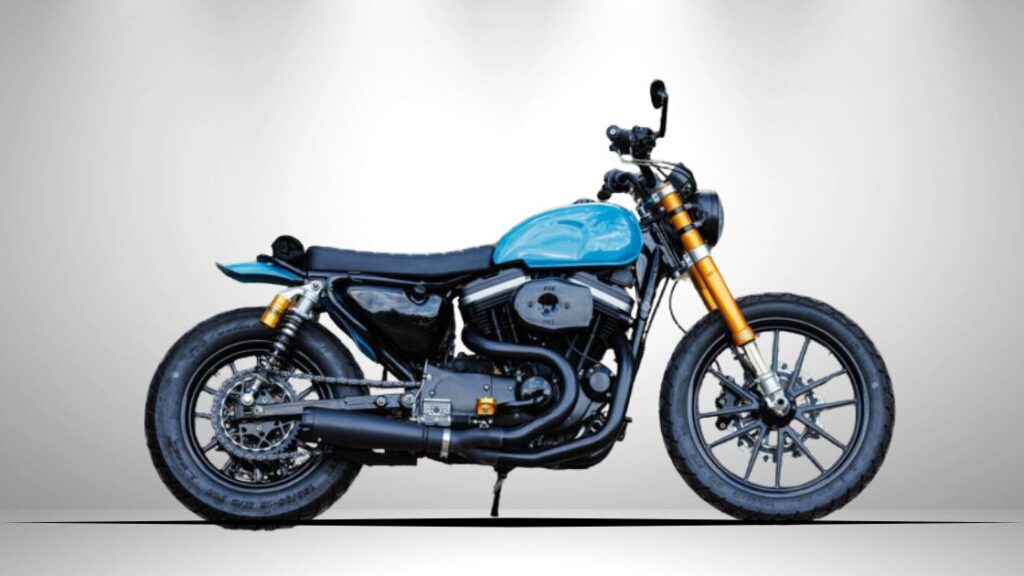
The seat is flat and short, often made for two riders. It sits low on the frame for a relaxed posture. The handlebars are simple, sometimes straight or slightly raised. The overall shape is narrow and clean. It removes extra parts that are not needed for basic riding.
Bratstyle bikes usually use old Japanese models like the Yamaha SR400 or Honda CB. These bikes are easy to modify. They are often used for city riding or short weekend trips. Bratstyle builds focus on personal expression with a mix of old-school and street-ready design.
What Is a Café Racer Motorcycle? (History, Speed & Style)
Café Racer is a custom motorcycle style that started in the United Kingdom during the 1960s. Young riders modified their bikes to be faster and lighter. The goal was to ride quickly between cafés and public spots. This gave the style its name.

Café Racers have a clear racing look. The seat is often narrow and shaped like a bump at the back. Handlebars are low and positioned to make the rider lean forward. This creates a sporty riding stance. The fuel tank usually has knee indents for better grip during sharp turns.
Builders often use older British and European bikes for Café Racer projects. Popular models include the Triumph Bonneville, Norton Commando, or BMW R-series. These bikes are known for their strong engines and classic frames. Café Racers focus on speed, performance, and a bold, clean look. They suit riders who want fast street rides with a classic edge.
Key Differences Between Bratstyle and Café Racer Motorcycles
Bratstyle and Café Racer motorcycles have clear design differences. Each style follows its own build method, shape, and parts layout. These differences affect how the bike looks, feels, and fits the rider. Below is a structured breakdown of their design features.
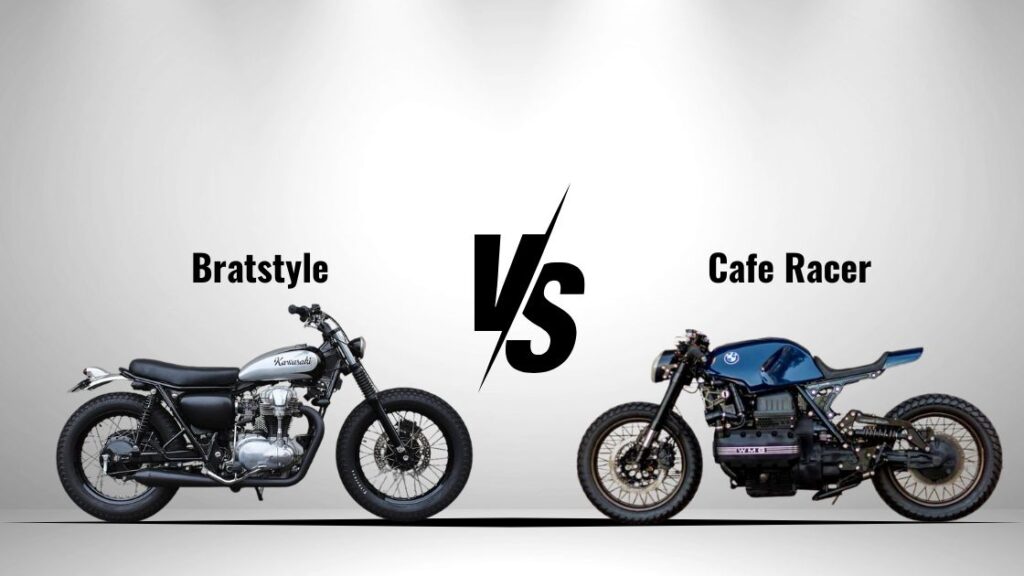
Seat Design
Bratstyle motorcycles use flat, padded seats. These are usually short and low. Many are long enough for two riders. The seat stays close to the frame to give a relaxed look. It fits with the minimalist build.
Café Racers use narrow, single-rider seats. The rear end often has a seat hump or cowl. This design supports a forward-leaning posture. It is meant for speed and function, not for carrying a passenger.
Handlebars and Controls
Bratstyle bikes often have mid-rise or straight handlebars. These allow a neutral riding position. The rider sits upright or slightly forward. Controls are placed for comfort and ease.
Café Racers have clip-on or low handlebars. These sit below the top of the fuel tank. The rider must lean forward to reach them. This setup lowers wind resistance and supports faster riding.
Tank and Frame Structure
Bratstyle fuel tanks are slim and simple. They follow the clean lines of the frame. The tank shape supports a laid-back build.
Café Racer tanks are usually longer and shaped for function. Some have knee dents for better grip. The tank often connects visually with the hump of the seat, creating a race-ready line from front to back.
Riding Comfort and Control: Bratstyle vs Café Racer
Bratstyle and Café Racer motorcycles offer different riding experiences. Their design affects how the rider feels on the road. Comfort, handling, and purpose all vary by style. This section explains how each performs in real use.
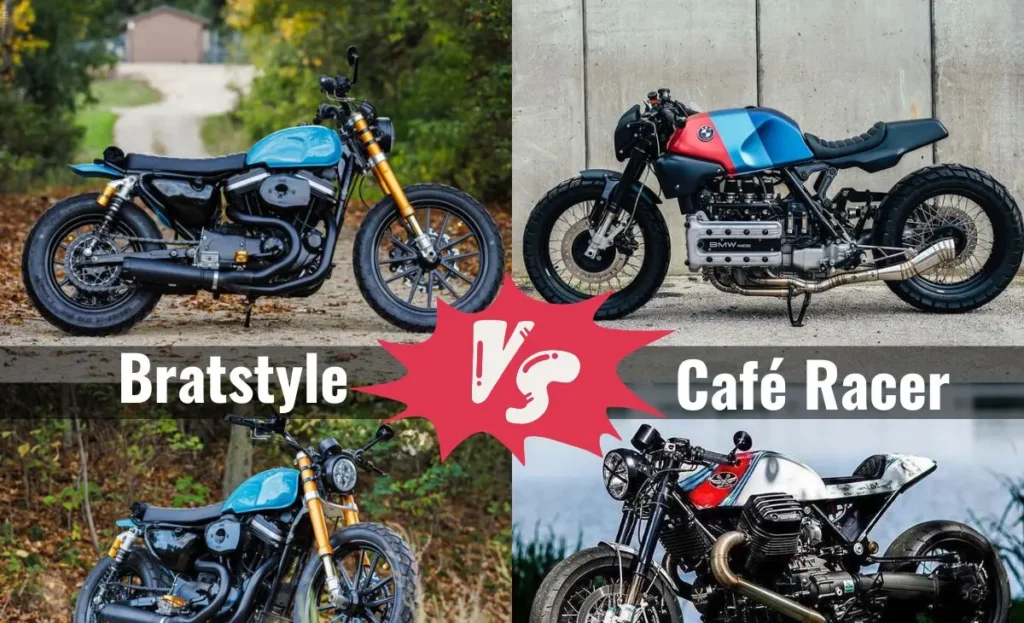
Riding Position
Bratstyle bikes support an upright riding posture. The seat is low, and the handlebars are mid-level or flat. This lets the rider sit in a natural and relaxed way. It helps during slow rides or short city trips. The position gives a clear view of traffic and surroundings.
Café Racers make the rider lean forward. The low handlebars pull the arms down and forward. Legs tuck back slightly. This creates a racing stance. It works well at higher speeds but can feel tight during long or daily rides.
Handling and Control
Bratstyle motorcycles handle well at low to moderate speeds. Their simple builds and flat seats help balance. They perform best in short-distance or city riding. The handling is steady and smooth on basic roads.
Café Racers focus more on speed and control in turns. Their lower center of gravity and lean-forward stance improve grip at higher speeds. They feel agile on winding roads. But the setup can feel stiff or tiring in traffic or slow rides.
Ride Comfort
Bratstyle offers soft comfort. The seat uses more padding. The suspension may keep a stock setup or use mild upgrades. This helps on rough or bumpy roads. The design gives a softer feel for casual riders.
Café Racer seats are firm and short. The suspension often feels tighter to improve handling. This setup supports sharp turns but may feel hard during long rides. The riding posture also puts more weight on wrists and arms.
Build Complexity, Parts, and Maintenance
Customization and maintenance are important when choosing between Bratstyle and Café Racer motorcycles. Each style has its own level of difficulty, cost, and build process. Knowing these details helps you plan your project better and keep the bike in good condition.
Build Complexity
Bratstyle motorcycles are simpler to build. They often keep the original frame and engine setup. Most changes are visual. Builders swap the seat, trim extra parts, and use standard handlebars. Many beginner builders choose Bratstyle for this reason. The layout is open and easy to understand.
Café Racers require more detailed work. The frame may need modification for the seat cowl. Handlebars must be changed to clip-ons. Fuel tanks often come from donor bikes. The build must follow a smooth racing line. This takes more time and planning.
Parts Availability
Bratstyle uses parts from older Japanese bikes. These models are still easy to find. Parts like seats, lights, and bars are available from many shops. Used components also fit well in most builds.
Café Racers often use vintage European or British bikes. Some models are rare. Finding parts can take longer and cost more. Custom pieces like tanks or rear seat cowls may not be ready-made. Builders often source or shape parts by hand.
Maintenance Needs
Bratstyle bikes use basic setups. The design stays close to stock. This makes repairs and service easy. Parts are low-cost and often interchangeable. Riders can handle simple repairs without a workshop.
Café Racers need regular checks, especially after deep custom changes. Racing-style seats, clip-ons, and lowered suspensions require more upkeep. The tighter setup may lead to faster wear on some parts. Maintenance costs can rise with older models.
Which is Better for Your Riding Needs Bratstyle or Café Racer?
Your riding habits, skill level, and daily routine help decide which style fits you best. Bratstyle is a better option if you want a bike for short city rides, casual weekends, or relaxed cruising. The upright seat and simple design make it easy to ride. You can enjoy it without pushing for speed. It also suits people who like to customize without advanced tools or deep mechanical knowledge.

Café Racers are built for those who enjoy fast, focused riding. If you like sharper turns, open roads, and sporty looks, this style fits better. The leaned-forward position and compact design work well at higher speeds but may feel less comfortable in traffic or on long rides. Café Racers also attract riders who enjoy detailed builds and unique frame work.
Think about your space, tools, and how often you ride. Bratstyle is for comfort, ease, and visual style. Café Racer is for speed, effort, and clean lines. The right choice depends on what you need from your motorcycle every day.
Bratstyle vs Café Racer Motorcycle Comparison Overview
Bratstyle and Café Racer motorcycles each offer distinct advantages and trade-offs. The right choice depends on your experience level, preferred riding conditions, and approach to customization. Below is a structured breakdown to help you evaluate both styles more effectively.
Bratstyle Key Advantages
- Easy to build with basic tools and minimal fabrication
- Comfortable for short rides, urban streets, and casual cruising
- Upright riding position supports relaxed, user-friendly control
- Compatible with widely available parts from older Japanese models
- Simple, stripped-down design reduces long-term maintenance needs
Bratstyle Key Limitations
- Limited focus on speed, torque, or performance handling
- Not ideal for highway travel or long-distance touring
- Aesthetic may lack bold impact for riders seeking aggressive styling
- Frame design restricts advanced modification options
- Resale value may be lower in broader motorcycle markets
Café Racer Key Advantages
- Striking visual appeal with classic race-inspired styling
- Engineered for improved speed, acceleration, and cornering
- Strong aftermarket interest from collectors and custom enthusiasts
- Offers deeper build satisfaction for skilled or experienced builders
- Sporty ergonomics suit riders focused on dynamic performance
Café Racer Key Limitations
- Reduced comfort during extended or stop-and-go rides
- More complex build process requiring fabrication and tuning skills
- Some parts may be costly or harder to source, especially vintage components
- Requires more frequent upkeep due to performance-focused setups
- Lean-forward posture may cause fatigue in city traffic or long sessions
This comparison helps align each motorcycle style with your riding goals, mechanical skill level, and preferred use case. Bratstyle offers simplicity and comfort. Café Racer prioritizes speed and design precision. Choose the one that matches how you ride and how you build.
Final Verdict: Choosing the Right Style for You
Select Bratstyle if you ride mainly in the city, prefer relaxed posture, and want a project you can finish with basic tools. The low seat, simple frame, and easy parts supply shorten build time and reduce cost. Comfort stays high on slow streets and short trips. Personal expression matters more than outright speed.
Choose Café Racer when you crave sharp handling and vintage race looks. The forward lean, tuned suspension, and cleaned frame reward confident cornering on open roads. The build demands more hours, rare parts, and skilled work, but the result feels fast and focused. Performance and style merge for riders who accept extra effort.
Is a Bratstyle motorcycle good for beginners?
Yes. Bratstyle bikes are simple, low in height, and easy to ride. Their upright position and basic controls suit new riders. The builds are also easier to modify with limited tools.
What kind of engine do Bratstyle motorcycles usually have?
Most Bratstyle bikes use single-cylinder or parallel twin engines. These engines are common in older Japanese models like the Yamaha SR400 or Honda CB, which are reliable and easy to work on.
How fast can a Café Racer go compared to a Bratstyle?
Café Racers are built for higher speeds. They often reach 90–120 km/h or more, depending on the engine. Bratstyle bikes focus more on style and comfort, with lower top speeds.
Which style is more fuel-efficient: Bratstyle or Café Racer?
Both styles can be fuel-efficient, especially with smaller engines. However, Bratstyle bikes tend to use lighter, lower-displacement engines, which may offer better mileage for city riding.
How much does it cost to build a Bratstyle or Café Racer?
Bratstyle builds usually cost less. You can start around $1,500 to $3,000 depending on parts. Café Racers often require more work and custom parts, so costs can rise above $4,000 to $6,000 or more.
Are Café Racers legal for road use in all countries?
Most Café Racers are street-legal if they follow local regulations. You may need working lights, mirrors, a horn, and emissions control. Always check your region’s motorcycle modification laws.
Can I buy a ready-made Bratstyle or Café Racer motorcycle?
Yes. Some custom builders and brands sell finished Bratstyle and Café Racer bikes. You can also find kits or donor bikes to simplify the process.
Do these custom styles affect insurance prices?
Yes. Custom motorcycles can lead to higher insurance rates. Insurers consider the build value, modifications, and repair cost. Some companies may require extra inspection or approval.
What kind of motorcycle frame works best for each style?
Bratstyle often keeps the stock frame, usually a double cradle or backbone. Café Racers may need a modified frame, sometimes trimmed to support a cowl seat and racing shape.
Do these bikes have storage or utility space?
Both styles offer minimal storage. Bratstyle may allow small rear racks or saddlebags. Café Racers usually avoid any add-ons to keep a clean, fast look.

